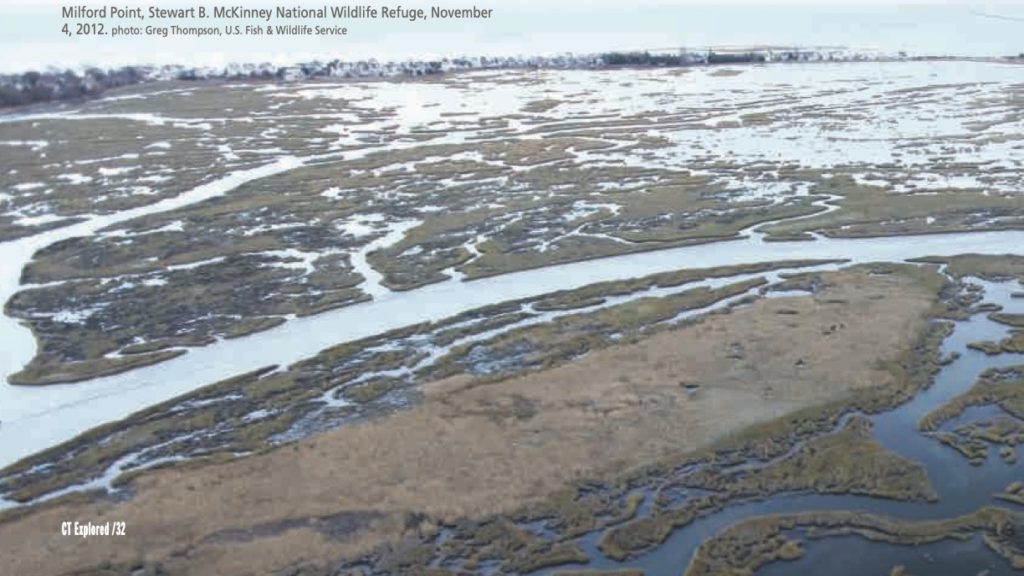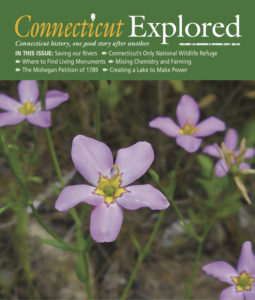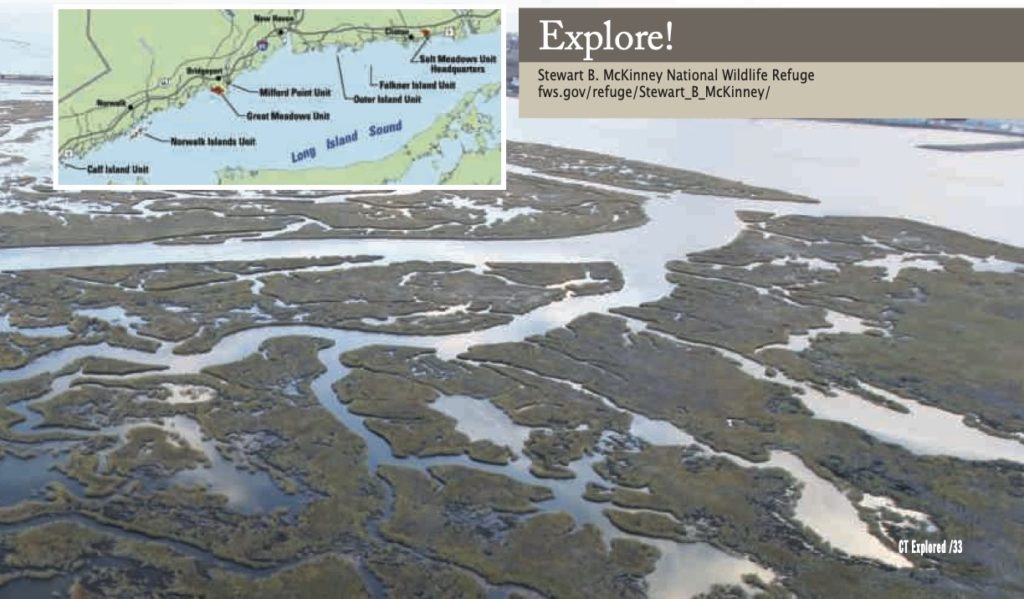By Johnna Kaplan

Milford Point, Stewart B. McKinney National Wildlife Refuge, November 4, 2012. photo: Greg Thompson, U.S. Fish & Wildlife Service
(c) Connecticut Explored Inc. Spring 2021
Subscribe/Buy the Issue!
The Stewart B. McKinney National Wildlife Refuge is the only national wildlife refuge in Connecticut, and, like the state itself, its small size belies its significance and beauty. Beginning with a single land donation in 1972, it has expanded to include more than 1,000 acres divided into 10 parcels—called units—spread along 70 miles of coastline from Greenwich to Westbrook. The refuge was named in 1987 to honor the late U.S. Congressman Stewart B. McKinney, who was instrumental in its creation.
From rocky islands to fragile barrier beaches, from sweeping salt marshes to shaded forests, the refuge is a haven not only for wildlife but for birders, boaters, hikers, history lovers, and anyone who appreciates Connecticut’s wild places. It preserves diverse habitats and provides abundant opportunities for research, education, and recreation. Located in the Atlantic Flyway though, the refuge is an essential resting, nesting, and feeding place for many species of birds, and the island units, which are important bird habitats, are largely off-limits to human visitors.
To those with access to private watercraft or anyone willing to wait for the rare public opening, many units offer opportunities for wildlife-watching and sightseeing. Falkner Island in Guilford and Sheffield Island in Norwalk are both home to notable lighthouses. The Falkner Island lighthouse, built in 1802, is the second-oldest in Connecticut. Sheffield Island’s lighthouse, built in 1868, shares its design with the Block Island North Light and other iconic lighthouses in the region. Both islands host occasional open events and tours.
Chimon Island in Norwalk is accessible by kayak, and Calf Island in Greenwich is open to visitors with small boats. The Outer Island Unit, part of the Thimble Islands off of Branford, may be reached by private boat or the Thimble Islands Ferry. It is used for education programs for students from middle school through college.
 Among the largest of the refuge’s units are three areas that are open to the public year-round and easily accessible by land. The Salt Meadow Unit in Westbrook was the first piece of property in the refuge and serves as the refuge’s headquarters. At first glance, this site looks like just another of Connecticut’s historic homes, and the striking stone house located here does have quite a history. Beginning in 1927, this property was the home of professor and journalist Esther Everett Lape and her partner, lawyer and activist Elizabeth Fisher Read. The couple’s close friend Eleanor Roosevelt was a frequent visitor; when the First Lady traveled here from New York, the train dropped her off discreetly along the tracks at the foot of the hill. Lape donated the property to the U.S. Department of the Interior in 1972. Today the slope Roosevelt climbed is traversed by connecting trails that wind through 340 acres of three distinct habitats: salt marsh, shrubland, and maritime forest. An observation deck overlooks the Menunketesuck River as it twists toward Long Island Sound. This unit also includes Menunketsuck Island, closed to the public for the safety of nesting and migratory birds.
Among the largest of the refuge’s units are three areas that are open to the public year-round and easily accessible by land. The Salt Meadow Unit in Westbrook was the first piece of property in the refuge and serves as the refuge’s headquarters. At first glance, this site looks like just another of Connecticut’s historic homes, and the striking stone house located here does have quite a history. Beginning in 1927, this property was the home of professor and journalist Esther Everett Lape and her partner, lawyer and activist Elizabeth Fisher Read. The couple’s close friend Eleanor Roosevelt was a frequent visitor; when the First Lady traveled here from New York, the train dropped her off discreetly along the tracks at the foot of the hill. Lape donated the property to the U.S. Department of the Interior in 1972. Today the slope Roosevelt climbed is traversed by connecting trails that wind through 340 acres of three distinct habitats: salt marsh, shrubland, and maritime forest. An observation deck overlooks the Menunketesuck River as it twists toward Long Island Sound. This unit also includes Menunketsuck Island, closed to the public for the safety of nesting and migratory birds.
In Milford, at the mouth of the Housatonic River, dozens of bird species pause along their seasonal migrations to take advantage of the shelter provided by a hook-shaped spit of sand. Behind the Connecticut Audubon Society’s Coastal Center at Milford Point, a raised boardwalk and observation deck lead to the 23-acre Milford Point Unit, adjacent to the larger state-owned Charles E. Wheeler Marsh Wildlife Management Area. Here, visitors can explore the delicate environment between the tidal marsh and Long Island Sound. Along this narrow strip of beach and dune, some of the area’s most endangered species, such as piping plovers and least terns, nest in safety. Like the Salt Meadow and Great Meadows units, the Milford Point Unit is a designated Important Bird Area, and bird watchers and wildlife photographers travel here to spot wading birds, shorebirds, and waterfowl along the mudflats and sandbars.

Stewart B. McKinney National Wildlife Refuge is made up of 1,000 acres in 10 parcels stretched across 70 miles of Connecticut’s coastline. Milford Point, Stewart B. McKinney National Wildlife Refuge, November 4, 2012. photo: Greg Thompson, U.S. Fish & Wildlife
Stratford’s Great Meadows Unit, improbably concealed behind busy roads and sprawling industrial parks, is a reminder that untouched places still exist along Connecticut’s heavily developed southwestern shore. In fact, at 421 acres, this watery landscape, where barrier beach blends into salt marsh and upland, is one of the state’s largest remaining coastal wetlands. (The Salt Meadow Unit in Westbrook is another.) Just past a patchwork of parking lots, a short trail leads to an observation blind and a window onto a diverse ecosystem sheltered from the open water by Lewis Gut and Long Beach. Here, visitors might spy northern harriers, kingfishers, and hundreds of other bird species. Keen observers will look down, too: just as other units of the refuge conceal floral surprises, such as the eastern prickly pear cactus, Great Meadows is the only place in Connecticut where the state endangered salt-marsh pink grows wild.
Johnna Kaplan is a freelance writer. She blogs at thesizeofconnecticut.com. She last wrote “The Charms of Boothe Memorial Park,” Spring 2020.
Explore!
Stewart B. McKinney National Wildlife Refuge
fws.gov/refuge/Stewart_B_McKinney/
GO TO NEXT STORY
Subscribe to receive every issue!
Sign up for our free bi-weekly e-newsletter
